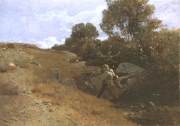

Plein-air painting liberated art from the artificial world of studios by reflecting light and colours as observed in nature. Light and shadow of open-air lighting and reflexes glittering urged artists work fast to register continuously changing colours of unique visions instead of stereotyped local colours, thus facilitating the development of impressionism.
The most important representative of plein-air in Central Europe was Pál Szinyei Merse (Balloon, 1878, Blooming Apple Trees, 1902; Poppies in the Field, 1902). In addition, mention must be made of Géza Mészöly (Lido, 1883), Béla Spányi (Calvary at Bodajk, 1880s), painters of the art schools of Szolnok (e.g. Gyula Aggházy: Landscape, 1878) and Nagybánya, e.g. Károly Ferenczy (Evening in March, 1902), Béla Iványi Grünwald (In the Valley, 1900; Drying Clothes, 1903), Simon Hollósy (Peasant Yard with Cart, 1912), Oszkár Glatz (Evening in the Snowy Mountains, 1897), István Csók (Winter in the Spring, 1913), István Réti (Landscape with Figure, c. 1906), furthermore Tivadar Zemplényi (Returning Home, 1897-98) and István Szőnyi (Landscape with Horse, 1920).